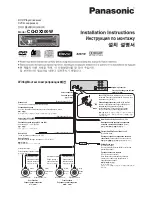
RFBA & RFBA Plus User Manual
Crown Broadcast
Page 19
new RDS Music/Speech.
If the RDS state is set to “OFF” or the MS SOURCE is not set to “PASS-THRU”
then this parameter will not be adjustable.
DI SOURCE:
The user can set the RDS encoder to use the received DI from Tuner #1 (“PASS-
THRU”) or the user specified DI (“USER”).Use the navigation keys to select the DI state. Push the
enter button to have the RFBA accept the new RDS DI state.
USER DI:
The user can set the RDS encoder Decoder Identification (DI) to a specified value. Use
the navigation keys to select the Decoder Identification. Push the enter button to have the RFBA
accept the new RDS Decoder Identification.
If the RDS state is set to “OFF” or the DI SOURCE is not
set to “PASS-THRU” then this parameter will not be adjustable. The valid values for DI are 0-15
where the least significant bit represents a mono/stereo flag. The RFBA will always use an
internal reference for the stereo pilot and this flag will always be “1”. Thus the RFBA only had
valid values of the odd numbered settings for DI {1, 3, 5…13, 15}.
CT SOURCE:
The user can set the RDS encoder to use the received Clock Time (CT) from
Tuner #1 (“PASS-THRU”) or off (“OFF”).Use the navigation keys to select the CT state. Push
the enter button to have the RFBA accept the new RDS CT state.
RT SOURCE:
The user can set the RDS encoder to use the received Radio Text (RT) from
Tuner #1 (“PASS-THRU”) or off (“OFF”).Use the navigation keys to select the RT state. Push
the enter button to have the RFBA accept the new RDS RT state.
SASS Alignment:
The Stand-alone Automatic Stereo Separation alignment menu is used to initiate
the stereo separation routine. To start this routine, connect the MPX output to the RF modulator
(transmitter). Connect the output of the RF Modulator to the Tuner #1 input at a level of 60 dBµV –
117 dBµV (+10dBm). Make sure that tuner #1 is set to the output frequency of the RF modulator
(this is done in the Tuner #1 setup menu). Once the connections are complete and tuner #1 is tuned
to the correct frequency then start the calibration. This will take less than 10 seconds. During the
calibration, the display will show the stereo separation as the algorithm achieves the maximum
value. Upon completion of the SASS the new calibration value will be stored in EEPROM. This
calibration should only need to be completed upon initial setup.
Network Setup Menu
The RFBA has capability to operate via an Ethernet connection. This menu allows the user to set the IP
and Subnet address for the RFBA. A description of each of the monitor features is detailed below:
N E T W O R K
→ I P :
1 9 2 . 1 6 8 . 0 0 1 . 0 0 1
S U B N E T :
2 5 5 . 2 5 5 . 2 5 5 . 0 0 1
G A T E W A Y : 0 0 1 . 0 0 1 . 0 0 1 . 0 0 1
M A C :
0 3 - A C - E 3 - 5 8 - B 5 - E F
Figure 12 - Network Setup Menu
















































